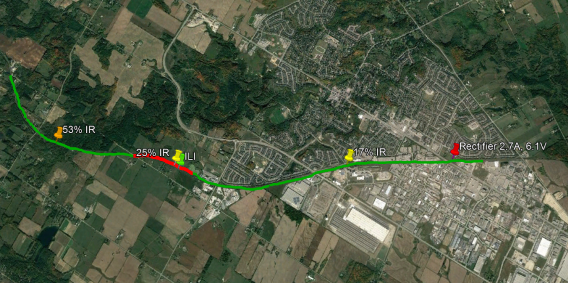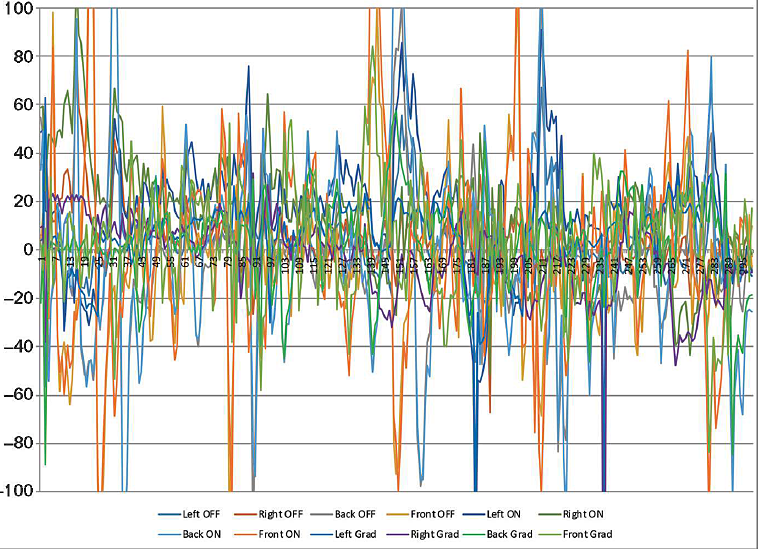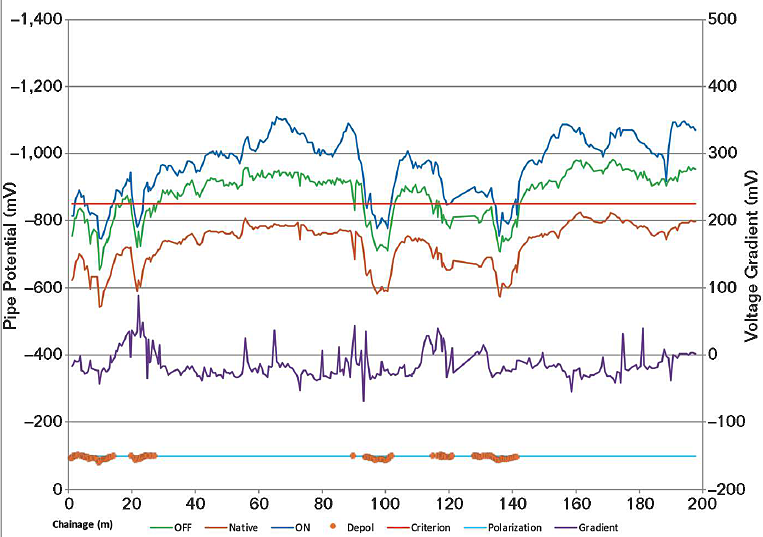As pipeline survey data increase with the use of close interval potential survey (CIPS) and direct current voltage gradient (DCVG) technologies in the cathodic protection (CP) industry, the way data are visualized has changed to reflect the increased amount of data.
Because each stakeholder—pipeline surveyor, analyst, and operator—needs to view and understand the data differently, how the data are formatted also needs to vary. The surveyor is limited to the options available on the instrumentation. The analyst has commercially available and proprietary software that can output several different graphical views, with a goal of optimizing visualization. The pipeline operator and regulators must be able to comprehend the data and make decisions for the continued operation of the pipeline.
History of Survey Instruments
Practical voltmeters were first developed in the 1880s and had a dial face connected to a moving coil galvanometer. This style of voltmeter is still used today as it is simple to manufacture and use.1 Beginning in the 1920s, the corrosion industry sent surveyors out to measure structure potentials and identify potential corrosion areas. Initially, the corrosion surveyors had limited instrumentation available to them. In the 1950s, the digital voltmeter was first invented (but it was not a practical device until semiconductors became readily available in the 1970s). One of the main developers of the digital voltmeter was Fluke Corp., a company still recognized today as a manufacturer of test and measurement tools.2
Voltmeters consisted of moving coil meters with various ranges and settings. Multiple-use meters were created by installing multiple meters within a case. Most of the equipment was large and heavy, making it difficult to use in an outdoor field environment. All recording was done manually and dependent on the interpretation of the surveyor. In the 1960s, an attempt was made to automate corrosion surveys by replacing handwritten notes with an amplifier connected to a paper chart recorder. While it could produce faster and more accurate results, it was not a practical, portable field instrument.3
Innovation continued through the years, driven by frustrated field surveyors, electronics technicians, and engineers. The explosion of semiconductors, integrated circuits, and computers in the 1970s and 1980s revolutionized the corrosion industry. Companies began to develop computerized instruments that could display the voltage readings, as well as record the voltage data for computer-assisted analysis. To evaluate the pipeline coating, the DCVG survey was developed in the 1980s and has typically been performed with very sensitive moving coil meters. Despite some digital meters being available, many surveyors prefer to use a dial voltmeter for simple interpretation in the field.

Survey accuracy improved since there was less opportunity for interpretation and transcription error. The electronic instruments could record the data faster, allowing the surveyor to obtain more readings and/or cover more ground. Liquid crystal displays (LCDs) were added to instruments for the first time to allow the surveyor some choices in how the data were presented—numerically or graphically. In the 1990s, the addition of global positioning satellite (GPS) capabilities kept the survey instruments in perfect synchronization with the supporting equipment, such as the current interrupters.4 This also sped up the survey, allowing more data to be recorded and ensuring that the surveyor could obtain proper IR-free CIPS measurements.
Now, new technological innovations, such as Bluetooth†, allow the integration of more survey methods and data into one instrument. Modern devices, such as the tablet and cell phone, can be used to display the survey data in a variety of formats.
Survey Stakeholders’ Needs
The three main types of corrosion industry professionals who need to monitor and visualize external corrosion direct assessment (ECDA) data are the surveyor in the field, the analyst in the office, and the pipeline operators/regulators in the field. Each has unique needs for the type, quantity, and presentation of the data.
The Surveyor
When performing pipeline integrity surveys, it is important for the surveyor to have a method to monitor the incoming data. This is the first step in quality control. Improving the quality of the raw field data leads to less post-processing and more accurate reports. With the use of electronic field instruments, it can be easier for the surveyor to verify that he or she is recording accurate data when the reading is taken; however, the success of this process depends on how the data are presented to the surveyor and the ease with which he or she can interpret them in fast moving field conditions.
A typical CIPS dataset involves two numbers: the structure’s potential with the CP “on” and the potential with the CP “off.” It is relatively easy for anyone to monitor two numbers and store the reading if those numbers are viable. The surveyor can determine whether they are practicable based on training and experience. By graphing the data on the survey instrument screen, the surveyor can also begin to perform some basic analyses in the field by looking for trends. If there is an abrupt change in the data, the data can be viewed immediately by the surveyor and investigated to validate or correct.

DCVG surveys can have increased complexity. Since the DCVG survey was invented, the standard field instrument has been an optimized moving coil dial meter. Higher end computerized CP survey instruments have offered electronic DCVG surveys, but the method of visualizing the data for the surveyor has not been widely accepted as it is not easy to read. Standard DCVG surveys are similar to a car speedometer: both are shown on dials since it is easy for a person to monitor for movement with a glance. Unlike CIPS, where the absolute precision of the reading is always important, the surveyor is initially looking for spikes or trends in the data when using DCVG. This can be monitored with a quick glance with an analog meter, but it is much more difficult to spot on an electronic survey using a digital display.

The availability of handheld computers and tablets has allowed increased flexibility in designing different interfaces for CP survey instrument users. The simplest implementation involves showing numbers on the screen, which is similar to digital meters. The next stage, especially for CIPS, is to show a graph on the screen. This allows the surveyor to monitor both the precise number being recorded and the overall trend of previous readings. The recent introduction of touchscreen tablets also has allowed for zoom functionality to be implemented, which permits the surveyor to review and, if necessary, focus on previous readings to quality check the work.
Modern graphical displays can now be programmed to mimic the older analog displays. An analog DCVG meter can be replicated graphically on a modern display device, such as a tablet. This display can improve the analog meter through accurately timed measurement and graphics manipulation. The analog DCVG meter shows movement if there is any change in the voltage in synchronization with the CP interruption cycle. The larger the shift or gradient, the closer the surveyor is to the coating defect. To monitor this effectively, the interruption cycle used to be set to a level that the human eye could see and the gradient later measured by the surveyor.
Now, using electronics and GPS synchronization, data measurement can be sped up considerably, and the gradient can be displayed in a more readable fashion. This is accomplished by using two needles on the graphics dial; the more distance between the two needles, the larger the gradient. Also, the instrument stores the DCVG “on” and “off” values for every reading, not just the defects the surveyor observes, so the analyst is able to confirm the presence or absence of a defect.

In addition, the direction of current flow can be detected with DCVG surveys. This indicates whether the current is flowing to the structure and is protected (positive value), or flowing away from the structure (negative value). A new graph, nicknamed “bird’s eye view,” gives a view from the top looking down at the survey team. It uses colored arrows to indicate the gradient current flow, and it offers the surveyor the choice to see the “on” and “off” readings separately or with the calculated gradient in real time. When this view is combined with additional DCVG channels on one device, it provides a straightforward method of locating the center of the defect.
The Analyst


In an ideal world, the analyst would receive data files in an easy-to-manipulate format with accurate data from the field. In the real world, however, a significant portion of the analyst’s time may be spent removing inconsistent readings, such as a poor contact or broken wire, before any conclusions about CP effectiveness or coating integrity can be reached.
There are some common practices within the industry for data clarity. Voltage values are shown on the vertical y-axis and plotted against distance on the horizontal x-axis. CIPS data are often presented with the axes reversed and a horizontal line for the criterion used, often –850 mV. DCVG data is usually centered around zero, with equal room on both the positive and negative portion of the axis.
The most common form of graphing data is to use an x- and y-axis plot that represents voltage vs. distance traveled, with the data scale showing the distance walked.4-5 Most other forms of graphing have a common fault—they spread the data points out evenly. This does not scale the data to the length of pipe walked or expose any areas missed by the surveyor.
As survey equipment has evolved, data can be obtained from multiple channels at the same time. Now, instead of three or four lines, there can be 10 or more. When displayed in a typical manner on one graph, the extra data create a visual mess, making it difficult to interpret. Three lines of survey data are typically present: CIPS “on,” CIPS “off,” and the DCVG gradient. Some analysts also add a line for the CP criterion of –850 mV. DCVG can also be graphed with three lines showing the DCVG “on,” DCVG “off,” and the calculated gradient. Attempting to show multiple channels, raw data, and calculated data all on the same graph can lead to visual confusion.
A combined CIPS and DCVG survey is one of the most common types of survey performed worldwide. It gathers information on the CP level and the coating integrity in one pass. The challenge when graphing the data is that CIPS values are typically between –700 and –1,500 mV, while DCVG values are between –50 and +50 mV, but can spike by 200+ mV in either direction. When graphed together, the CIPS values are easy to read but the DCVG values are often very small and hard to decipher. By changing the DCVG line to a secondary y-axis, the scaling of the DCVG readings can be adjusted to emphasize the appearance of any defects. If available, the analyst may add other data such as a polarization study or inline inspection indications to the graph.
Performing a double impedance CIPS survey allows the analyst to calculate the true potential of the pipeline in high-resistance conditions. If the calculated potential is graphed along with the low and high readings, there are six lines of data in the same space—too many to easily interpret. To emphasize the calculated true potential of the pipe, the data from the low and high impedance readings are adjusted to be a lighter color or more transparent. The same technique can be used when combining data over different years or when doing a depolarization study; lighter colors are used for older data and darker colors are used for the current condition. If any of the data sets are very close together, the lines will stack on the graph and both results may not be visible.
Obtaining two DCVG channels with a CIPS survey can provide extra clarity when surveying in congested areas. The surveyor and analyst can confirm that the defect shown in the data belongs to the pipe being surveyed rather than a neighboring pipe. Depending on the terrain, the surveyors may be walking to either side of the pipe being surveyed (lateral) or walking in a line on top of the pipe (longitudinal). These two scenarios present different graphical results. As with the CIPS and DCVG discussed earlier, it is important to separate and scale the DCVG results separately from the CIPS. This can be done with both DCVG on a secondary y-axis or by creating stacked graphs.
The Pipeline Operator

The pipeline operator has many inputs to monitor. These may include current operational conditions, equipment status, employees, financial markets, and more. Corrosion protection is one small—yet important—item. All data, reports, databases, and analyses need to be combined to provide the data that the pipeline operator needs. Usually this is to answer one question: Is my asset protected and in compliance with the regulations?
There are many tools to use for collecting and processing the survey data to help answer this question. They include the ECDA process, prioritization calculations, defect sizing, and others.
Assembling and distilling this information is necessary, and failure to properly analyze the source data can lead to catastrophic errors.
During most corrosion-related surveys, information about the location of each reading is commonly obtained, either through chainage or GPS coordinates. As this information is readily available, it can be used to produce reports that are easier to comprehend. By creating icons and colors for certain types of results and overlaying those results on a satellite or similar map, a better view of the overall pipeline integrity can be understood. This can be combined with other information about the pipeline (e.g., assets, high consequence areas, age, etc.) if available.
Conclusion
Technological improvements for measurement and data processing have created more data and more ways to view the data. This can lead to improvements at all levels. As the surveyor records higher quality data, it is easier for the analyst to interpret it. As the analyst utilizes more information sources, it is easier for the pipeline operator to make informed decisions. The technology creates an opportunity to tailor the data display for the diverse needs of each individual.
This article is based on CORROSION 2018 paper no. 11518, “New Visions for CIPS & DCVG,” by Elizabeth Nicholson.
References
1 Edison Tech Center, “Voltmeters,” Universe of Instrumentation, http://www.edisontc.org/ui/home/course/unit-i/voltmeters/ (September 26, 2017).
2 Edison Tech Center, “Digital Multimeters,” Universe of Instrumentation, http://www.edisontc.org/ui/home/course/unit-i/multimeters/ (September 26, 2017).
3 R.J. Finch, “Recording Pipeline Corrosion Surveys,” Proceedings of the Ninth Annual Appalachian Underground Corrosion Short Course (Morgantown, WV: West Virginia University, 1964), pp. 388- 399.
4 W.B. Holtsbaum, Cathodic Protection Survey Procedures, 3rd ed. (Houston, TX: NACE International, 2016).
5 A.W. Peabody, Control of Pipeline Corrosion, 2nd ed. (Houston, TX: NACE International, 2001).
Bibliography
Nicholson, J.P. “Is Your Pipeline Corroding?” CORROSION 2008, paper no. 09123. Houston, TX: NACE International, 2008.
Smart, A.L. “Early CIS—From the Backpack to the Slurpy Cell.” CORROSION 2009, paper no. 09131. Houston, TX: NACE, 2009.